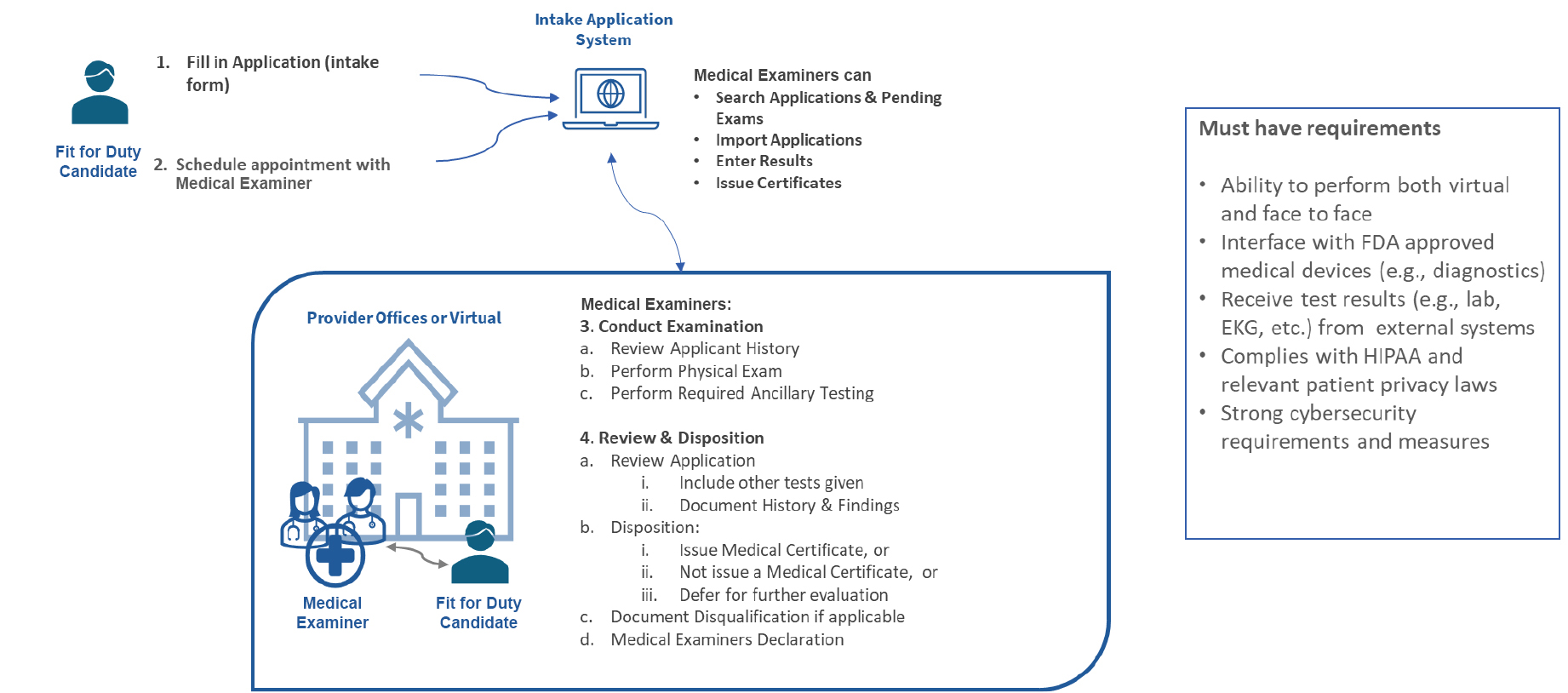Background and Objectives
Background
Medical certification and supporting physical examinations are needed across a wide range of safety sensitive jobs and occupations. The Federal Government is interested in increasing the efficiency of the process as well as improving the experience for prospective job applicants. Telemedicine provides an opportunity to modernize the process through standardization and better documentation of medical history and physical examination results. These improvements are envisioned to provide equitable access to a wider range of applicants.

Figure 1: Medical Examination Workflow
Challenge Objectives
MITRE is interested in your perspectives on strategies to identify effective telehealth practices, including devices and methods, to improve medical history taking and physical examination documentation. Specifically, this challenge seeks information and insight related to the below objectives:
- Elicit applicable telemedicine capabilities and leverage the industry to rapidly prototype and determine the feasibility or practicality of telemedicine for certification exams.
- Evaluate adoption challenges with preferential focus given to medical history and physical exam elements with the greatest role in mitigating workplace safety risks. This includes emphasis on visual, auditory, cardiovascular, pulmonary, neurological, and musculoskeletal systems as well as evaluation of mental and behavioral health.
- The hypothetical workflow of medical history and physical examination process is summarized in Figure 1 above.
- The assessed technologies and modalities could include health apps, video conferencing and data transmission capabilities, as well as medical devices and measurement applications with data transmission and/or storage capabilities.
Thinking Broadly…
- Consider the art of possible: How would you reorder the traditional process of history and physical to improve efficiency using telemedicine and related technologies?
- What combination of the face-to-face and virtual elements of the physical exam are feasible?
- What elements of testing can be done remotely?
- What is the logical sequence for physical exam and testing (e.g., lab, ECG, hearing, vision)?
- How could remote physiologic monitoring be used?
- What technologies for data collection and standardization could be used?
- How can telemedicine technologies improve the conduct and reliability of the face-to-face examination process?
- Could the traditional face to face examination be replaced with a telemedicine enabled virtual visit?
Examination Sample Elements
Listed below are the physical tests and conditions that the healthcare providers require during the examination.
Physical Testing
- Visual Acuity
- Phoria (Prisms, Red Maddox Rod, Eye Muscle Test Light)
- Color Vision (Pseudoisochromatic Plates, Commercial Vision Testers)
- Field of Vision
- Hearing testing
- ECG (electrocardiogram)
Example of health conditions requiring documentation
- Cardiovascular disease (hypertension, coronary artery disease, myocardial infarction, heart failure, arrhythmia, etc.)
- Cardovascular procedures (PTCA, stent, ablation, valve repair, valve replacement, pacemaker, ICD, etc.)
- Diabetes mellitus (requiring insulin or other hypoglycemic medication)
- Vision disorders (retinal conditions, limited vision, etc.)
- Hearing disorders (loss of hearing, tinnitus, etc.)
- Neurological conditions (seizures, stroke, tremor, movement disorders, etc.)
- Vertigo, balance disorders
- Behavioral Health (personality disorder, psychosis, depression, panic disorder, anxiety, bipolar disorder, etc.)
- Substance abuse or dependence
- Orthopedic conditions (back, neck, shoulder pain, etc.)
